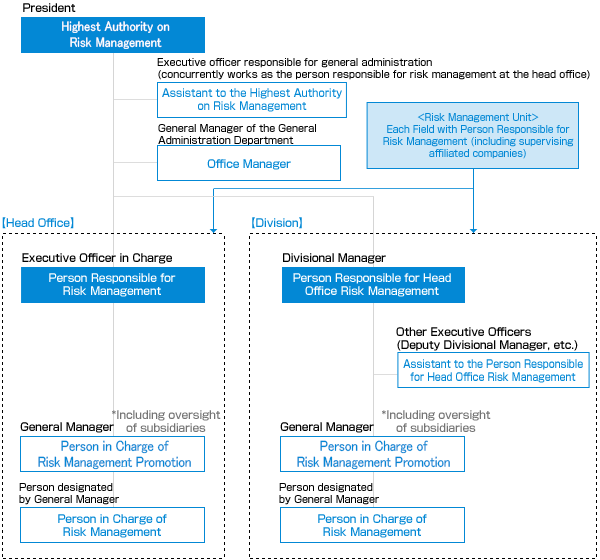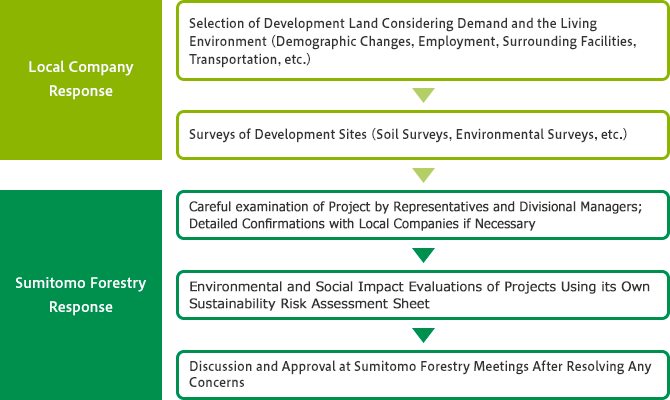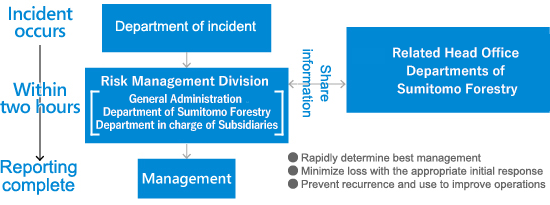- Home
- Sustainability
- Governance
- Risk Management
Risk Management
Risk Management Framework
In order to reinforce its framework for managing business risks for the entire Group, Sumitomo Forestry has created the Risk Management Basic Regulations and has appointed the President of Sumitomo Forestry as the highest authority on risk management for the Sumitomo Forestry Group. Executive Officers in charge of each Division have been appointed authorities on risk management of their department, and general managers have been appointed to promote risk management. The Regulation encompasses risks in environmental, social, and governance aspects, comprehensively.
The Risk Management Committee is chaired by the President. Committee members consists of Divisional Managers and designated General Managers of each division, General Manager of the Corporate Planning Department, Personnel Department, Legal Department, IT Solutions Department, and Sustainability Department. The Committee meets once every quarter to analyze and evaluate risks identified from each division, selects priority management risks, and prioritizes monitoring the progress of responses to those of particularly high importance. A Compliance Subcommittee and a Business Continuity Management (BCM) Subcommittee have also been established under the command of the Risk Management Committee to carry out specific activities for increasing effectiveness of responses to compliance and business interruption risks regarded as cross-sectional risks affecting the Group. The details of these activities are reported and submitted to the Board of Directors. In fiscal 2024, Risk Management Committee was held four times, Compliance Subcommittee was held twice, BCM Subcommittee was held twice, and reports to Board of Directors were made four times respectively.
In addition, the Internal Audit Department assesses the status of risk management through internal audits of each department and Group company, and reports the audit results to the Board of Directors.
Risk Management Structure of the Sumitomo Forestry Group

We keep developing specific measures to improve the effectiveness in our response to environmental, social, and governance risks and emerging risks described in Sumitomo Forestry Group Code of Conduct. With respect to issues such as climate change and nature-related matters, international trends are considered together with the business conditions of each Division in order to evaluate risks and opportunities that are anticipated to have a significant financial impact at both the corporate and divisional levels. Since fiscal 2019, each Division has worked together to conduct scenario analysis based on TCFD and analysis based on TNFD’s LEAP approach.
The Sustainability Committee discusses items determined through this process to be priority risks in the medium to long term, reports to the Board of Directors about its activities in the same way as the Risk Management Committee, and reflects this into business execution.
- Click here for related information
Project Monitoring Committee
In 2023, we established the Project Monitoring Committee to monitor all risks related to new business projects, product development, and other projects, from internal approval of project implementation to the start of business. The department in charge of a project reports to the Project Monitoring Committee on the progress of the project and possible risks, and each member evaluates the risks. In addition, the Committee Secretariat reports the proceedings of meetings to the President, and the President instructs the Secretariat to (1) provide feedback to the department in charge of instructions and findings, (2) report to the President from the department in charge, and (3) report to the Executive Committee, depending on the status of the matter.
Risks in Operations
The following risks have been identified in operations as stated on the Security Reports.
- Risks related to trends in housing and real estate markets worldwide
- Risks related to procurement and sales of raw materials, timber and building materials
- Risks related to declining number of skilled construction workers in Japan
- Legal and regulatory risks
- Foreign exchange risks
- Risks related to raising capital
- Quality assurance risks
- Risks related to granting credit to business partners
- Overseas business risks
- Risks of mountain forests and planted forest operation locations held and managed
- Risks related to information security
- Risks related to accounting retirement benefits
- Risks related to the environment including climate change as well as loss of nature and biodiversity, etc.
- Risks of emergency situations caused by natural disasters, etc.
- Risks related to infringement of human rights
- Click here for related information
Below are three specific examples of individual risks faced by Sumitomo Forestry, along with detailed explanations.
Risks Associated with Illegal Logging and Conversion Timber
Illegal logging is recognized as a crucial issue globally, and progress is being made to strengthen related laws and regulations in a number of countries and regions. Japan has announced the Act on Promotion of Use and Distribution of Legally-Harvested Wood and Wood Products (The Clean Wood Act) on May 20, 2016, which was enacted on May 20, 2017. On May 8, 2023, the Act Partially Amending the Act on Promotion of Distribution and Use of Legally Harvested Wood and Wood Products (commonly known as the "Amended Clean Wood Act") was enacted and came into effect on April 1, 2025. Addressing stronger control of illegally harvested wood not only responds to the requirements of the world but it is also extremely important for the Sumitomo Forestry Group to continue businesses sustainably. Departments and affiliated companies registered by the Sumitomo Forestry Group submit performance reports each year to the registration agencies certified by the Japanese government. In recent years, there is a growing interest on the sustainability of the forest from which timbers are sourced, in addition to the legality of the procured timber and wood products. "Conversion timber" is timber generated during the conversion of natural forest areas to non-forest use (such as oil palm plantation). While the conversion to farm land is often discussed from the commodity side (oil palm, soy, rubber and cattle), conversion timber now poses sustainability risks to forestry industry.
- Click here for related information
Impact on the Sumitomo Forestry Group
The Sumitomo Forestry Group could jeopardize its own businesses that handle wood resources if it neglected its duty and dealt in illegally logged timber. Moreover, these actions would harm the image of the Company and could directly damage our business performance such as compensation for damage and turnover.
Risk Countermeasures
The Sumitomo Forestry Group has been committed to responsible wood procurement, pioneering legislation in Japan and having established the Timber Procurement Philosophy and Policy in 2005, to bring contributions to a sustainable society via business activities of "wood," a renewable resource. In 2015, Timber Procurement Philosophy and Policy was extended beyond wood and became subject to procurement of building materials, raw materials of products, and end products, and reestablished as Sumitomo Forestry Group Procurement Policy. We have also been engaged in responsible wood procurement activities since 2018, formulating the Timber Procurement Management Regulations and Timber Procurement Due Diligence Manual among other measures. Sumitomo Forestry has drafted and is executing an action plan to accomplish by the end of fiscal 2021 founded in the fiscal 2019 actions for strengthening due diligence through the Timber Procurement Committee and diffusing the use of sustainable forests and wood to promote the procurement of timber from more sustainable forests.
- Click here for related information
Risks Associated with GHG Protocol Revision - Forest Carbon Removal Recognition
Forestry sector is currently the only sector that can remove carbon dioxide from the atmosphere through photosynthesis and trees store carbon. However, unlike national emission inventory report to IPCC, corporate carbon accounting does not include carbon removal from land sector and storage for biogenic products.
The Nature based Solutions (NbS) and Natural Climate Solutions (NCS) have now been receiving much attention for mitigation. The GHG Protocol, a de facto standard of carbon accounting for corporates co-developed by the World Resource Institute and the WBCSD, is now developing new guidance reflecting strong demand for the area of land use, land use change and natural (biogenic) carbon removals. However, although many reporting frameworks refer to the GHG Protocol, the release of this new guidance has been delayed from its initially scheduled date.
It is imperative for the land sector to be able to report carbon removal with a relatively easy-to-handle inventory accounting protocol. Otherwise, it may hinder investment flow for the forest sector.
Impact on the Sumitomo Forestry Group
In 2023, Sumitomo Forestry launched its first forest fund offering future carbon credit for hard to abate sectors. In its long-term vision, "Mission TREEING 2030", the Company disclosed the targets to expand its forest operation areas from 280,000 hectares of fiscal 2021 to 1,000,000 ha by 2030. For the whole sector and for Sumitomo Forestry, unless forest carbon removals and biogenic carbon storage be recognized through easy-to-handle accounting protocol, it may hinder investment flow for the forest sector.
Also, Sumitomo Forestry has been promoting wooden mid-to-large scale buildings in addition to the wooden detached houses in Japan, the U.S. and in Australia. Substituting effect of construction materials to biomaterial, namely wood, has been recognized as an effective transitional pathway for the carbon neutral society. Visualization of the carbon sequestration effect of biogenic material is key and globally accepted protocol would greatly help pushing the agenda forward.
Risk Countermeasures
Sumitomo Forestry has been actively engaged in lobbying through the Forest Solutions Group of the WBCSD (World Business Council for Sustainable Development) and CDP Japan Club, where Sumitomo Forestry serves as member. Also, we joined the newly established International Sustainable Forestry Coalition in December 2023 to better collaborate among industry peers. Through FSG, four of which members are official members of TWG of the GHG Protocol Land Sector Removal Guidance Revision, we participated in the pilot test from September 2022 to February 2023, and also provided feedback. Carbon removal through forest sequestration is the only currently-available-solution (and Nature based Solutions), which is imperative for the transition towards the carbon neutral society.
Risks Associated with New Emerging ESG Mandatory Disclosures
In June 2023, the International Sustainability Standards Board (ISSB) released its inaugural standards which set out requirements for sustainability-related (IFRS S1) and climate-related (IFRS S2) financial disclosures (ISSB Standards) for business entities. The new standards consolidate the requirements of multiple other leading sustainability reporting frameworks and is mandated by regulatory authorities. While it is a welcoming trend for business in a long run with a globally unified standard to report against and lowering cost of sustainability disclosure, transitional period poses a great risk for companies to adopt to new mandates coming into forces on a different time scale in each country.
Sumitomo Forestry, headquartered in Japan and listed on the Tokyo Stock Exchange Prime Market, is required to follow the regulations by the Financial Agency of Japan, which plans to adopt the ISSB standards in 2025. In addition to Japan, the Group operates businesses in approximately 30 countries, engaging in procurement and sales, and the decisions made in each of these countries affect the Group. These sustainability disclosure requirement trends coincide with our rapid growth in overseas operations through mergers and acquisitions. This poses great challenges to the Group especially in the data collection and management of social-related non-financial information.
Impact on the Sumitomo Forestry Group
While we have already made and updated our Scope 3 disclosures, some of the ISSB disclosure requirements are time-consuming and costly. For example, this includes concurrent reporting with financial disclosures, information on sustainability-related risks and opportunities linked to financial reporting, and obtaining broader third-party assurance. With the EUDR already in place and IFRS expressing their intention to expand information disclosure to biodiversity, human rights, and human resource development in the supply chain, the impact of risks that should be mitigated by the Group, which operates businesses using forest-derived products, is expected to intensify. Failure to meet disclosure requirements or disclosing incorrect information jeopardizes our brand image and market access, as well as our financing activities.
Risk Countermeasures
Sumitomo Forestry Group has been conducting Internal Sustainability Survey since 2012 to collect non-financial information, review sustainability readiness of each Group entity and to implement any necessary measures to mitigate risks. Building up on these initiatives, in June 2024, a Task Force team was formed among Corporate Planning, Finance and Sustainability Departments to incorporate necessary measures in the upcoming mid-term sustainability target to be ready for the SSBJ (Japan's jurisdictional body to determine how to adopt ISSB requirements) requirements for fiscal 2027 report. The Task Force has also been exchanging views with relevant authorities on foreseeable challenges for the whole society, especially for smaller enterprises.
New Business Plan Risk Assessment
All new business and project plans that are brought for deliberation to the Board of Directors and the Executive Committee, which is the advisory body to the president, Sumitomo Forestry conducts risk assessment for the following categories, considering the entire supply chain. If a risk is confirmed, a report is made regarding the risk and measures to deal with it, which is used to determine implementation. In addition, the same risk assessment is recommended for new business projects that are not brought for deliberation to these meetings because they can be implemented under the jurisdiction of the respective Division or affiliated company. In fiscal year 2024, 14 new businesses and projects were discussed. In particular, with regard to greenhouse gas (GHG) emissions, we plan to introduce internal carbon pricing (ICP) to understand GHG emissions associated with business activities and their financial impact. As part of the risk assessment process, we are planning to report estimated GHG emissions and ICP-related costs. To better understand the specific financial impact, we also plan to revise our checklist to include items on emission volumes and monetary impact.
| Environmental Aspects |
|
| Social Aspects |
|
| Legal and Regulatory Compliance | Status of Legal and Regulatory Compliance |
| Overall | Recognition of Indications from External Organization About Business Models, Products, Services and the Related Business Entities |
Understanding and Assessing Housing and Real Estate Development Risks
Properly understanding the geological and geographical risks unique to each property is vital in the development of housing and real estate. The Sumitomo Forestry Group has put in place the necessary systems to verify whether there are any issues through careful surveys at the assessment stage of development in addition to other multistage checks done before determining how to implement a project.
In overseas development, for example, we first select the land to develop and then outsource soil and environmental surveys to external research firms to fully understand the risks from an objective standpoint. We not only ask local affiliated companies to give their input on risks but the Sumitomo Forestry head office also conducts property inspections and environmental and social impact studies using its own sustainability risk assessment sheet for projects larger than a certain scale. Management also provides feedback through meetings at the Sumitomo Forestry head office to analyze risks from diverse multistage perspectives. We only engage in projects determined to be acceptable through this process.

Construction also comes with the risk of occupational accidents during the construction phase. Sumitomo Forestry complies with occupational health and safety laws and works to prevent occupational accidents at local affiliated companies and also puts in place systems to immediately report any accident that occurs to the headquarters so it can quickly understand what happened as well as plan and execute measures to prevent recurrence.
Risk Education
We not only provide risk management and compliance training when Executive Officers and employees join the Company but also conduct e-learning for all Group Executive Officers and employees every year to enhance the risk sensitivity of Sumitomo Forestry Group Executive Officers and embed it in our corporate culture. In fiscal 2024, we also conducted risk management training for risk management promoters and those responsible for risk management.
In addition, we are periodically conducting training on corporate law and corporate governance, including those of Sumitomo Forestry's Outside Directors and Outside Audit & Supervisory Board Members.
- Click here for related information
Prompt Identification and Response to Risks
The Sumitomo Forestry Group implements Two-hour Rule reporting system designed to quickly and accurately communicate information to management in the event of an emergency situation that may have a grave impact on company management. In addition to the regular reporting line, it utilizes communication via the Division responsible for risk management. Through this system, management can take the best decision swiftly, ensuring an initial response which avoids loss and controls the situation. Moreover, it serves a role in collecting and accumulating reported cases and assists in improved business practice and prevention of recurrence.
At our overseas sites as well, employees report back assessed risks. For example, some sites have introduced the system where supervisors install safety management application on their mobile phones that allows swift reporting of risks and incidents when they occur, or that implement an incentive system for making suggestions upon discovery of an event that is one step away from a serious accident (near-miss). Through these initiatives, we are raising awareness among employees to make it easier to discover risks.
Furthermore, the structure is organized so that, by sharing information with the public relations departments, important situations are disclosed to stakeholders properly and in a timely manner.
Two-Hour Rule and Use of Risk Information

- Home
- Sustainability
- Governance
- Risk Management

